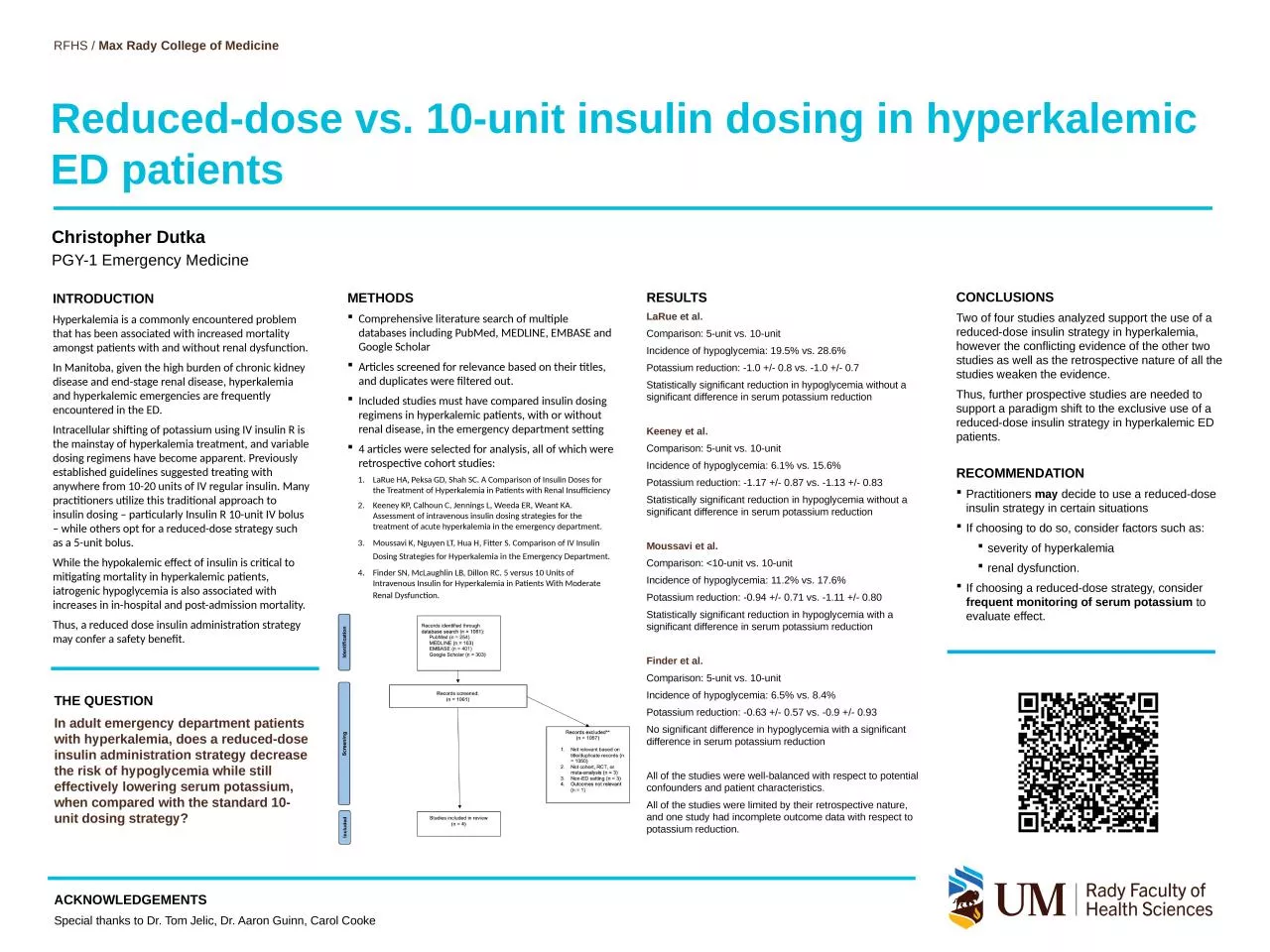

ACKNOWLEDGEMENTS Special thanks to Dr Tom Jelic Dr Aaron Guinn Carol Cooke THE QUESTION In adult emergency department patients with hyperkalemia does a reduceddose insulin administration strategy decrease the risk of hypoglycemia while still effectively lowering serum potassium whe ID: 1009410
Download Presentation The PPT/PDF document "Reduced-dose vs. 10-unit insulin dosing ..." is the property of its rightful owner. Permission is granted to download and print the materials on this web site for personal, non-commercial use only, and to display it on your personal computer provided you do not modify the materials and that you retain all copyright notices contained in the materials. By downloading content from our website, you accept the terms of this agreement.
1. Reduced-dose vs. 10-unit insulin dosing in hyperkalemic ED patientsACKNOWLEDGEMENTSSpecial thanks to Dr. Tom Jelic, Dr. Aaron Guinn, Carol CookeTHE QUESTIONIn adult emergency department patients with hyperkalemia, does a reduced-dose insulin administration strategy decrease the risk of hypoglycemia while still effectively lowering serum potassium, when compared with the standard 10-unit dosing strategy?INTRODUCTIONHyperkalemia is a commonly encountered problem that has been associated with increased mortality amongst patients with and without renal dysfunction.In Manitoba, given the high burden of chronic kidney disease and end-stage renal disease, hyperkalemia and hyperkalemic emergencies are frequently encountered in the ED.Intracellular shifting of potassium using IV insulin R is the mainstay of hyperkalemia treatment, and variable dosing regimens have become apparent. Previously established guidelines suggested treating with anywhere from 10-20 units of IV regular insulin. Many practitioners utilize this traditional approach to insulin dosing – particularly Insulin R 10-unit IV bolus – while others opt for a reduced-dose strategy such as a 5-unit bolus.While the hypokalemic effect of insulin is critical to mitigating mortality in hyperkalemic patients, iatrogenic hypoglycemia is also associated with increases in in-hospital and post-admission mortality.Thus, a reduced dose insulin administration strategy may confer a safety benefit.METHODSComprehensive literature search of multiple databases including PubMed, MEDLINE, EMBASE and Google ScholarArticles screened for relevance based on their titles, and duplicates were filtered out.Included studies must have compared insulin dosing regimens in hyperkalemic patients, with or without renal disease, in the emergency department setting 4 articles were selected for analysis, all of which were retrospective cohort studies:LaRue HA, Peksa GD, Shah SC. A Comparison of Insulin Doses for the Treatment of Hyperkalemia in Patients with Renal InsufficiencyKeeney KP, Calhoun C, Jennings L, Weeda ER, Weant KA. Assessment of intravenous insulin dosing strategies for the treatment of acute hyperkalemia in the emergency department. Moussavi K, Nguyen LT, Hua H, Fitter S. Comparison of IV Insulin Dosing Strategies for Hyperkalemia in the Emergency Department. Finder SN, McLaughlin LB, Dillon RC. 5 versus 10 Units of Intravenous Insulin for Hyperkalemia in Patients With Moderate Renal Dysfunction. RESULTSLaRue et al.Comparison: 5-unit vs. 10-unitIncidence of hypoglycemia: 19.5% vs. 28.6%Potassium reduction: -1.0 +/- 0.8 vs. -1.0 +/- 0.7Statistically significant reduction in hypoglycemia without a significant difference in serum potassium reductionKeeney et al.Comparison: 5-unit vs. 10-unitIncidence of hypoglycemia: 6.1% vs. 15.6%Potassium reduction: -1.17 +/- 0.87 vs. -1.13 +/- 0.83Statistically significant reduction in hypoglycemia without a significant difference in serum potassium reductionMoussavi et al.Comparison: <10-unit vs. 10-unitIncidence of hypoglycemia: 11.2% vs. 17.6%Potassium reduction: -0.94 +/- 0.71 vs. -1.11 +/- 0.80Statistically significant reduction in hypoglycemia with a significant difference in serum potassium reductionFinder et al.Comparison: 5-unit vs. 10-unitIncidence of hypoglycemia: 6.5% vs. 8.4%Potassium reduction: -0.63 +/- 0.57 vs. -0.9 +/- 0.93No significant difference in hypoglycemia with a significant difference in serum potassium reductionAll of the studies were well-balanced with respect to potential confounders and patient characteristics.All of the studies were limited by their retrospective nature, and one study had incomplete outcome data with respect to potassium reduction.Christopher DutkaPGY-1 Emergency MedicineRFHS / Max Rady College of MedicineCONCLUSIONSTwo of four studies analyzed support the use of a reduced-dose insulin strategy in hyperkalemia, however the conflicting evidence of the other two studies as well as the retrospective nature of all the studies weaken the evidence.Thus, further prospective studies are needed to support a paradigm shift to the exclusive use of a reduced-dose insulin strategy in hyperkalemic ED patients.RECOMMENDATIONPractitioners may decide to use a reduced-dose insulin strategy in certain situationsIf choosing to do so, consider factors such as:severity of hyperkalemiarenal dysfunction.If choosing a reduced-dose strategy, consider frequent monitoring of serum potassium to evaluate effect.